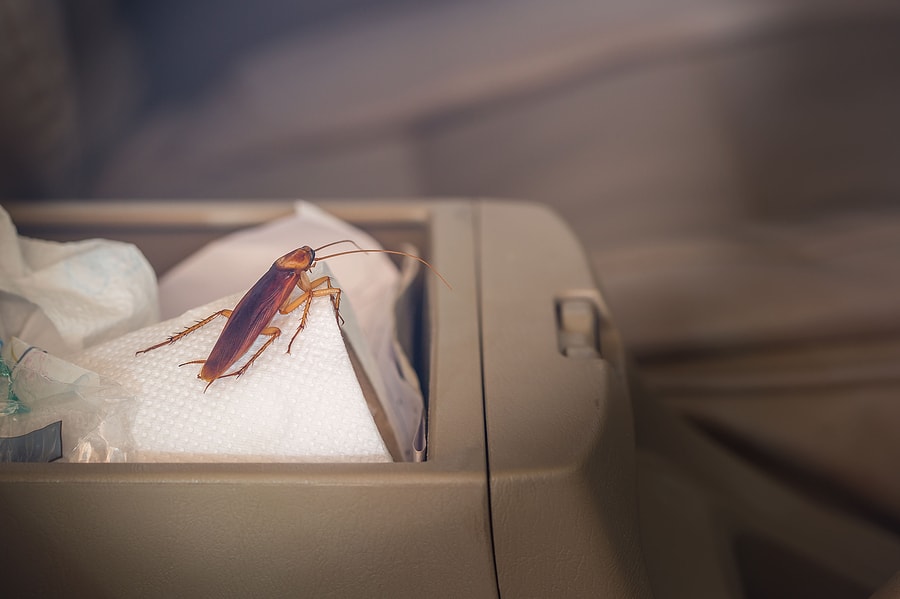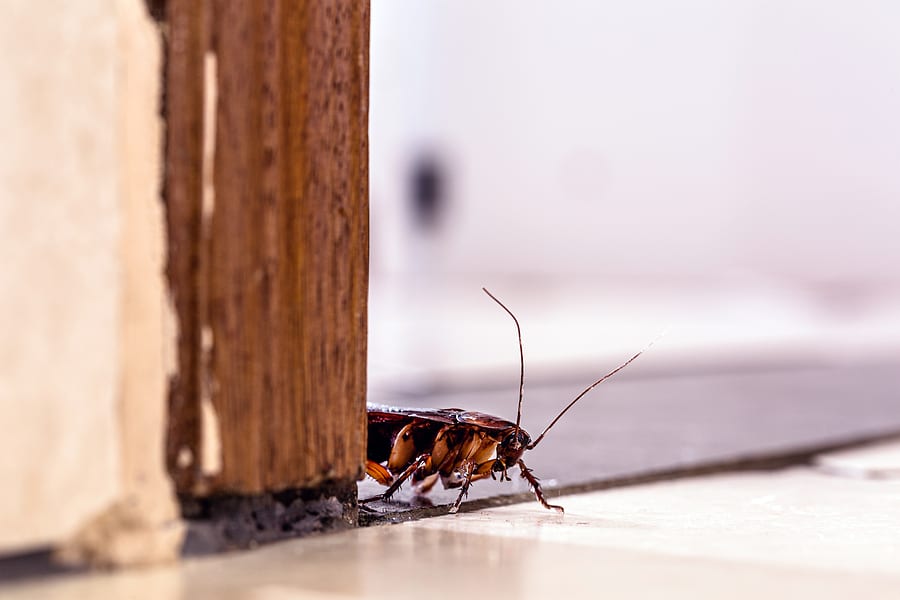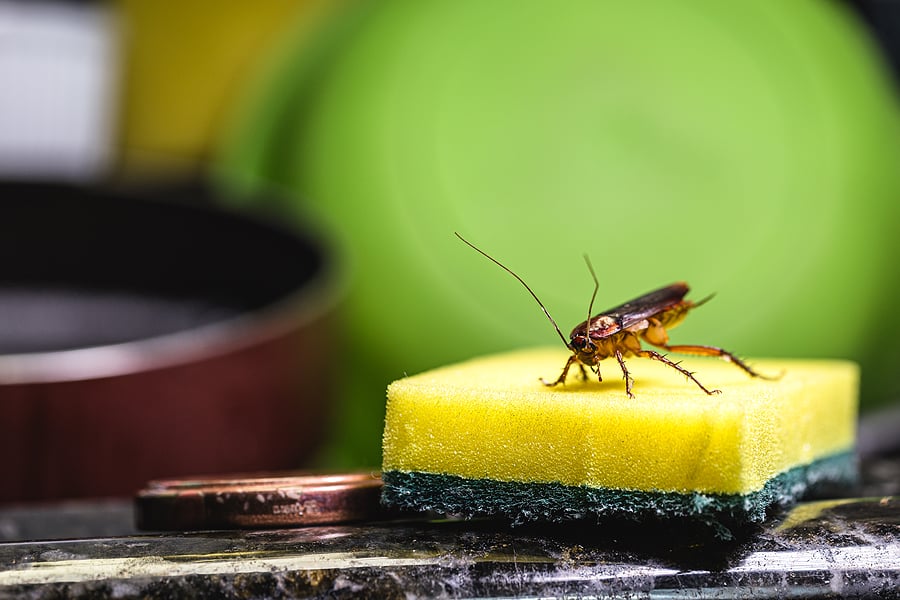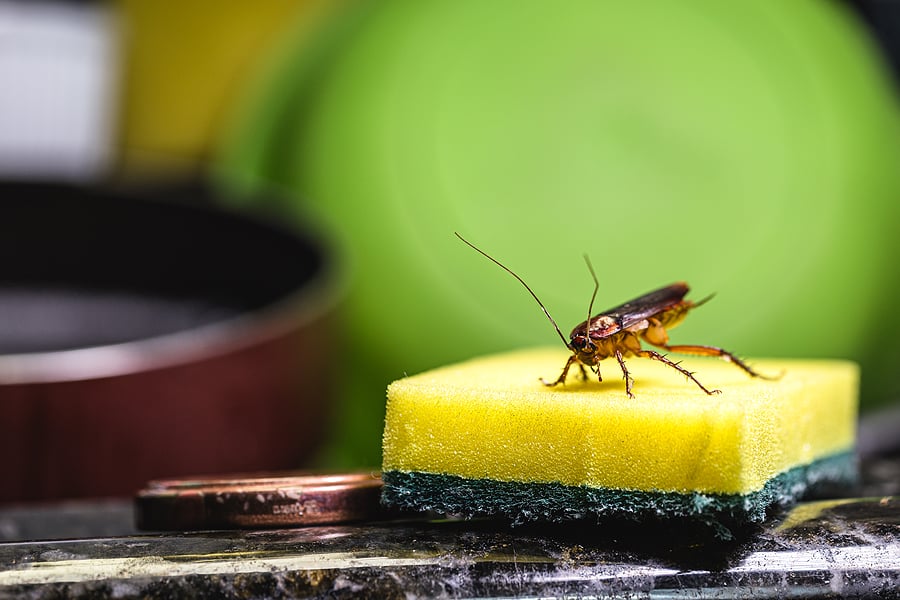READY TO GET STARTED?
REQUEST A FREE ESTIMATE
Fill out the form below or call (888) 466-7849 for a free, no-obligation estimate.

Cockroaches are one of the most common household pests that homeowners have to deal with. These pests are resilient and are known to survive under the harshest conditions. So why do these pests seem so hard to get rid of? What are the best methods to eliminate them from making their way inside your home?
Cockroaches are built to be almost indestructible. Roaches have exoskeletons made up of overlapping plates connected by a stretchy membrane. This membrane is so flexible that it can allow them to fit through small cracks and crevices. Along with their stretchy membrane, they also have a thick outer layer that can protect them and shift when needed.
Since roaches can use their bodies to fit through small areas, they are great at surviving in harsh conditions. Cockroaches will find shelter to avoid harsh temperatures and other predatory pests that threaten them.
While cockroaches are durably built and sneaky, it doesn’t mean that they are impossible to keep from getting inside your home. Consider utilizing these roach prevention tips:

The last thing a homeowner wants to deal with is a pest infestation. One of the most common household pests is the cockroach, multiplying at a rapid rate and taking over in practically no time. The most common roaches found in households are American cockroaches, German cockroaches, and brown-banded cockroaches. Just because you see roaches in your home doesn’t mean you live in a dirty house; what attracts cockroaches may surprise you! Here are 5 common ways to attract cockroaches and how to prevent them.
Roaches thrive in dark, warm, moist, humid environments. Some of the most common sources of water in your home include leaky pipes under sinks and tubs, damp basements, AC units that leak, roof leaks, standing water, and piles of wet leaves. It is important to manage any moisture problems as soon as possible. Routinely inspect these areas of your home for leaks and fix them immediately. Consider enclosing your crawlspace to help control moisture under your home. Make sure gutters are functioning and downspouts are pointed away from foundations. Consider installing gutter guards to help prevent clogs.
Roaches will also come into your home in search of food and they will eat anything they can find. Roaches will forage in the garbage can for food scraps, grab any crumbs or food residue left on counters or floors, and can even chew through thin plastic or cardboard food containers. Make sure to clean your floors regularly by sweeping, mopping, and vacuuming. Wipe down countertops and stoves each night. Wash dishes nightly and empty the garbage regularly. Store food in plastic or glass containers rather than cardboard boxes.
One of the main things roaches eat are fibrous, organic materials found in paper and cardboard. Roaches love to feed on cardboard storage boxes that go undisturbed for long periods of time in attics, garages, and basements. Declutter as much as possible, getting rid of old boxes, newspapers, and magazines. Try to use plastic storage containers rather than cardboard boxes when possible.
Roaches don’t just get their food and water from humans. They are notorious for hijacking pet food and water bowls, especially at night, in their quest for survival. Try to feed your pets multiple times throughout the day rather than once at night. Don’t leave pet food or water bowls out overnight. Store pet food in airtight plastic containers rather than pet food bags. Clean up any spilled pet food and water, especially at night.
If your neighbors have a problem with cockroaches, there is a good chance you’ll end up with them, as well. This is especially true for apartments and other attached homes but can also occur with single family homes that are in close proximity to each other. Unfortunately, there isn’t much you can do to prevent your neighbors from getting an infestation; but you can take the above preventative steps and schedule routine pest control for your home to help keep them away.
Roaches can be extremely difficult to control and eliminate once they have established themselves in your home. If you have a problem with cockroaches or any other pests, contact a reliable pest control company who can identify the type of pest you are dealing with and provide you with an appropriate treatment and prevention plan.
Preventing a Mosquito Infestation
When Should You Start Fall Lawn Care?

Cockroaches are household pests known for spreading bacteria and triggering allergies and asthma. These nocturnal pests come out at night to feed and hide in cracks and crevices during the day. Roaches are attracted to moisture and are most commonly found in bathrooms, kitchens, laundry rooms, basements, and drains. Because they are nocturnal, you may not notice you have a roach problem until a full blown cockroach infestation has set in. Spotting the signs of cockroaches can help you head off an infestation before it gets out of hand. Here are 7 signs you may have cockroaches.
If your neighbors mention having a roach problem, especially if you live in an apartment, condo, or townhouse, the odds are likely that they will make their way over to your home, as well. One way to help prevent this is by getting rid of what attracts roaches in your home. Don’t put open food containers in the trash; don’t leave crumbs on the floor; clean up messes as they happen; keep garbage cans sealed; and try not to store outdoor trash cans near your home.
Roaches are attracted to moisture so they are often found in areas of high moisture in your home. In these areas, they will often produce dark, irregularly-shaped smear marks as they rest or crawl along walls. These smears are often seen on horizontal surfaces and where the wall and floor meet.
Roaches leave droppings behind wherever they are. The size and shape of droppings vary between species. Some species leave behind a small brown stain. German cockroaches leave behind pepper-like specks that can also resemble coffee grounds. The larger American cockroach species leaves behind droppings closer to a grain of rice. The most common places to check for droppings are floor corners, cabinets, under the fridge, and under the stove. It is important to clean any droppings up when you find them as they are known to spread bacteria.
Egg casings are long, hollow, light brown tubes that hold cockroach eggs, anywhere from 20 to 50 at a time. Although most species leave egg casings behind once the eggs are laid, some species actually carry them with them until their offspring hatch. Egg casings are usually found at the base of the refrigerator, in cabinets that store food, and near leaky pipes. If you find a casing that still has eggs in it, dispose of it by flushing it down the toilet.
Roaches and their feces give off a musky, unpleasant odor. While one roach usually doesn’t emit a strong enough odor to be detected by humans, when larger numbers of roaches get together the smell gets stronger and more easily detected. While the smell is usually associated with live roaches, dead cockroaches can also emit the odor as part of the decomposition process.
The feces and exoskeleton of cockroaches contain proteins that can trigger allergies and asthma. If you don’t usually have allergies and have symptoms appear without a known trigger; or your current allergy and asthma symptoms seem to get worse without a known trigger this may indicate the presence of cockroaches in your home. Symptoms include stuffy nose, wheezing, red itching eyes, shortness of breath, chest tightness, and the increased use of your inhaler.
If you see one roach, the odds are likely that there are many others present. Roaches are nocturnal and usually spotted at night. If you are seeing roaches during the day, overcrowding from an infestation may be forcing them out in the open.
The best way to avoid a roach infestation is to prevent them in the first place. Prevent cockroaches by:
If you have a problem with roaches or any other pest, contact your local pest control company for a free analysis and comprehensive treatment plan.
Bed Bugs: Where Do They Come From?
How to Prevent Little Black Ants

Although cockroaches are considered a year-round pest, their populations swell in the summertime. Particularly in the southeast, roaches cause problems for both residential and commercial properties during these hot summer months. Cockroaches are hardy pests that are highly adaptable to a variety of conditions. They particularly thrive in warm, humid environments, which are readily available in the hot, muggy summer heat. Infestations are more likely in the summertime because this increase in temperature spurs them to feed and reproduce at a much faster rate. When the temperature gets too hot, even roaches that usually stay outdoors will make their way into your home or business in search of food, water, and shelter.
How can you prevent a cockroach infestation this summer? Check out these tips to prevent cockroaches from taking over your home.
Roaches will come indoors in search of food and water. Eliminating their food source is one way to discourage them from coming into your home. Don’t leave dirty dishes in the sink overnight; wash them and put them away after each meal. Clean up any crumbs or spills immediately. Wipe up any grease from the stovetop and other appliances. Seal food, including pet food, in airtight containers. Mop and vacuum on a regular basis. Don’t leave pet food or water out overnight. Take out the garbage before going to bed. Use garbage cans with tight fitting lids. Wipe out the trashcan regularly. Make sure to check behind cabinets and appliances for spills/crumbs. Roaches like these areas because of the warmth the appliances give off combined with the likelihood of spilled food.
Roaches hide out during the day so they will seek out dark, protected areas to hole up in until nightfall. Declutter your home and get rid of anything they can use for shelter. Roaches also love to breed in cardboard and newspaper. Recycle any old newspapers and get rid of unused cardboard boxes. Try to use plastic storage containers rather than cardboard boxes if possible.
Roaches are very creative when it comes to finding ways into your home. A good rule of thumb is if you can see daylight around a door or window, roaches can get in. Inspect at least once a year around windows and doors, along foundations and the roof, attic and crawlspace vents, and around holes used for electric, gas, and plumbing lines. Seal any cracks and holes you find. Use caulk to seal smaller holes, steel wool or foam for larger holes, and fine wire mesh on chimneys and attic vents.
Roaches (along with many other pests) are attracted to moisture because they need water to survive. Regularly inspect your home for any leaking faucets, sinks, or pipes and check refrigerators and appliances to make sure they aren’t producing excess moisture. Get any known leaks or plumbing issues fixed immediately.
Prevention can only get you so far when it comes to keeping roaches out. Nothing eliminates a pest as well as professional service. If you suspect you have a roach infestation, contact a pest control company who can thoroughly inspect your home to help identify which type of cockroach you are dealing with, help identify any potential areas where they are getting in, provide you with the most up-to-date elimination and control methods, and help you with a prevention plan going forward.
What Do Swarming Termites Mean?
How To Help Your Lawn During Late Summer

While cockroaches are active year-round, the humidity and warm weather of spring make this a prime time of year for these pests to invade your home. Roaches prefer environments that are warm and contain moisture which is why they are most often seen in kitchens and bathrooms inside your house. They can also multiply quickly and can adapt to just about any environment, making them extremely difficult to get rid of. Cockroaches are dangerous to humans in that they are known to carry and transmit serious diseases, can contaminate food and other surfaces in your home, and trigger allergies and asthma.
The most common types of roaches in our area are the German cockroach, the American cockroach, the brown-banded cockroach, and the Oriental cockroach. What attracts roaches are food, water, and warm shelter, all of which can be found in your home. Roaches are commonly drawn to crumbs, spills, dirty dishes, garbage, pet food, open food containers, cardboard, paper, glue, and excess moisture. In order to keep cockroaches out of your home, the goal is to make it as unattractive to them as you can. Check out these tips to help prevent cockroaches.
Roaches are attracted to dirt and filth because they provide a source of food for them. Keeping your home clean helps eliminate these food sources, making them go elsewhere in search of something to eat. Wash your dishes and put them away after meals. Clean up any crumbs and spills. Empty the garbage before going to bed. Clean grease from your stovetop. Seal any leftover food in containers. Sweep, mop, and vacuum on a regular basis. Don’t leave pet food out overnight.
The less clutter in your home, the fewer places roaches have to hide. Besides that, cockroaches love to breed in newspaper and cardboard. Keep your home as clutter free as possible. Dust regularly. Get rid of any old newspapers and magazines. Use plastic storage bins instead of cardboard boxes whenever possible.
Roaches can squeeze through the tiniest of holes, especially around windows and doors, along foundations and roofs, in attics and crawlspaces, through vents, and into holes used for gas, electric, and plumbing. Inspect your home for any possible entry points and seal them up. For smaller holes seal with caulk; for larger holes seal with steel wool or foam; and for vents and chimneys cover with fine wire mesh.
Roaches love moisture and need water to survive. Routinely check your home for leaks and plumbing issues, especially around faucets, sinks, refrigerators, and other appliances. Repair any leaks you find immediately. Keep basements and crawlspaces dry and well ventilated. Consider enclosing your crawlspace to help keep these pests at bay.
Cockroach prevention doesn’t have to rely solely on chemicals. There are several natural roach repellent and elimination products available today. Some of the most common include:
For the most effective preventative and ongoing roach control, have your home inspected and treated on a regular basis – usually monthly or quarterly – by a professional pest control company. These professionals can provide you with a thorough inspection to help identify what type of pest you are dealing with, the most likely points of entry they are using, and the most up-to-date treatment and prevention options available.
Preparing for Spring Lawn Care